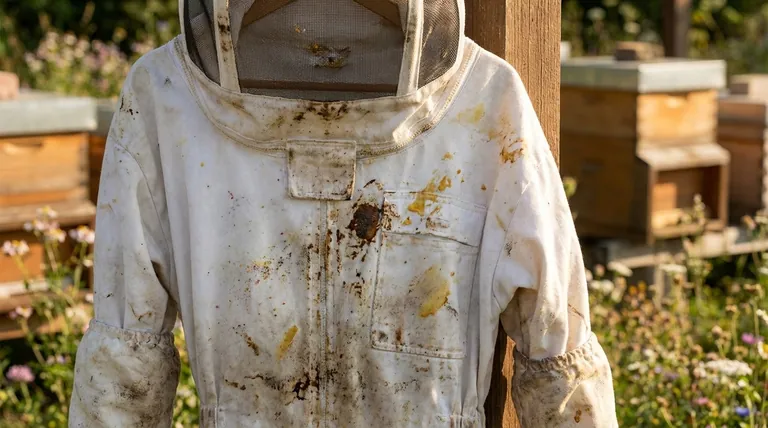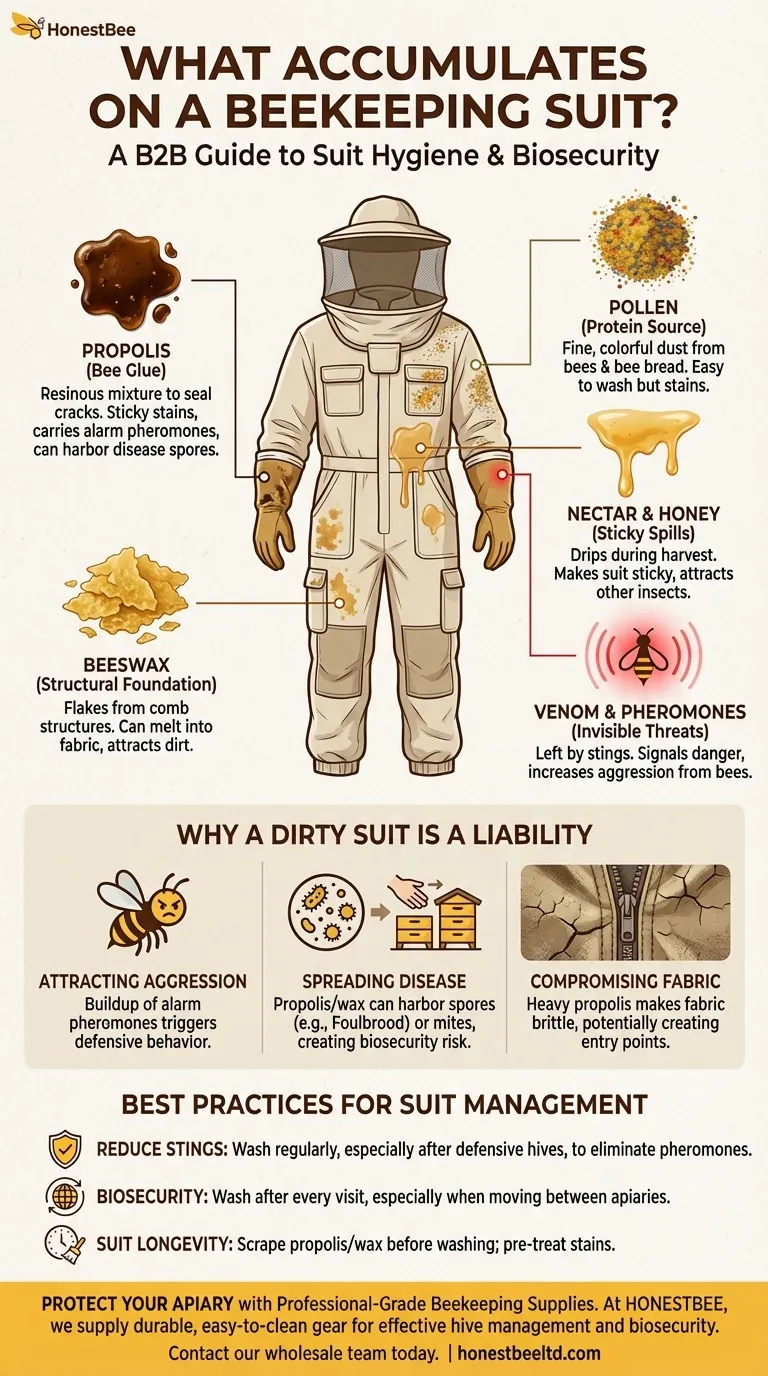Over time, your beekeeping suit becomes a record of your work. It inevitably accumulates a combination of substances directly from the hive. The most common materials you'll find are sticky propolis, flakes of beeswax, colorful pollen dust, and general dirt or grime from the apiary environment.
The buildup on your suit is more than just dirt; it carries hive-specific scents, potential pathogens, and alarm pheromones. A clean suit is a critical tool for minimizing bee aggression and preventing the spread of disease between your colonies.

The Key Contaminants on Your Suit
Understanding what is on your suit helps you understand its impact. Each substance has unique properties and implications for you and your bees.
Propolis: The "Bee Glue"
Propolis is a resinous mixture bees produce to seal cracks and defend the hive. It’s incredibly sticky and is often a beekeeper's biggest laundry challenge.
This substance builds up as dark, tacky stains on your gloves, cuffs, and anywhere you brace a frame against your body. It can also carry the scent of alarm pheromones.
Beeswax: The Structural Foundation
Small flakes and smears of beeswax are unavoidable. This happens when you scrape burr comb or accidentally crush comb structures.
While less problematic than propolis, wax residue can melt and set into the fabric, attracting and holding onto dirt.
Pollen: The Protein Source
Pollen appears as a fine, often colorful dust. It gets on your suit when you brush against bees or the frames they've packed with "bee bread."
Pollen stains are generally easy to wash out but can make a suit look perpetually dirty.
Nectar and Honey: The Sticky Spills
During inspections and especially during harvests, drips and splashes of nectar or honey are common.
These sugary spots make your suit sticky and can attract bees, ants, or yellow jackets to you, both in and out of the apiary.
Venom and Pheromones: The Invisible Threats
When a bee stings your suit, it leaves behind venom and, more importantly, alarm pheromones.
This pheromone signals "danger" to other bees, marking you as a threat. A suit that has been stung and not washed will provoke a more defensive response from bees on your next visit.
Why a Dirty Suit is a Liability
A soiled suit isn't a badge of honor; it's a potential risk to both you and your colonies. Keeping it reasonably clean is a core part of good hive management.
Attracting Unwanted Aggression
The most immediate issue is the buildup of alarm pheromones. Washing your suit, particularly the gloves, effectively resets this "threat signal," leading to calmer inspections.
The Risk of Spreading Disease
Propolis and wax can harbor microscopic disease spores, such as American Foulbrood, or even Varroa mites.
Wearing the same unwashed suit while moving between different apiaries is a significant biosecurity risk. You can unknowingly become the primary vector for an infection.
Compromising the Suit's Fabric
Heavy propolis buildup can make the fabric stiff and brittle over time. This can compromise the integrity of the material and zippers, potentially creating entry points for determined bees.
Best Practices for Suit Management
Your approach to suit care should align with your beekeeping goals. It's about managing risk and maintaining a calm, healthy apiary.
- If your primary focus is reducing stings: Wash your suit regularly, especially after working with a defensive hive, to eliminate alarm pheromones.
- If your primary focus is biosecurity: Wash your suit after every visit, especially if you are moving between apiaries, to prevent cross-contamination of diseases.
- If your primary focus is suit longevity: Scrape off excess propolis and wax before washing and consider pre-treating stains to keep the fabric effective and clean.
A clean suit is not just a preference; it's a fundamental tool for responsible and effective beekeeping.
Summary Table:
| Substance | Source | Key Impact |
|---|---|---|
| Propolis | Bee glue for sealing hive | Sticky stains, carries alarm pheromones, can harbor disease spores |
| Beeswax | Scraped comb structures | Can melt into fabric, attracts dirt |
| Pollen | From bees and 'bee bread' | Colorful dust, easy to wash but causes staining |
| Honey/Nectar | Spills during inspections/harvest | Attracts other insects, makes suit sticky |
| Alarm Pheromones | Deposited from bee stings | Triggers defensive behavior in bees, increases stinging risk |
Protect Your Apiary with Professional-Grade Beekeeping Supplies
A clean suit is your first line of defense for maintaining calm, healthy hives and preventing the spread of disease. At HONESTBEE, we supply commercial apiaries and beekeeping equipment distributors with the durable, easy-to-clean suits and protective gear needed for effective hive management and biosecurity.
Contact our wholesale team today to discuss your apiary's needs and discover how our equipment can support your operation's success and longevity.
Visual Guide

Related Products
- 3 Layer Mesh Vented Sting Proof Beekeeping Suit with Hat and Veil
- Cotton Beekeeping Suit and Round Hat with Veil Bee Keeper Protective Gear
- Vented Beekeeping Jacket with Hood and Veil for Beekeepers
- Yellow Plastic Bucket Pail Perch for Beekeeping
- Long Langstroth Style Horizontal Top Bar Hive for Wholesale
People Also Ask
- What are the advantages of reinforced stitching and durable zippers in beekeeping suits? Ensure Maximum Safety & Longevity
- What are the key features to look for in beekeeping clothing? Ensure Maximum Safety & Comfort
- What features should be considered for sting protection in a beekeeping suit? Ensure Total Safety and Comfort
- What should be worn under beekeeping protective clothing? Maximize Your Safety with the Right Base Layer
- What should be considered regarding the color of beekeeping clothing? Ensure Your Safety and Keep Bees Calm



















